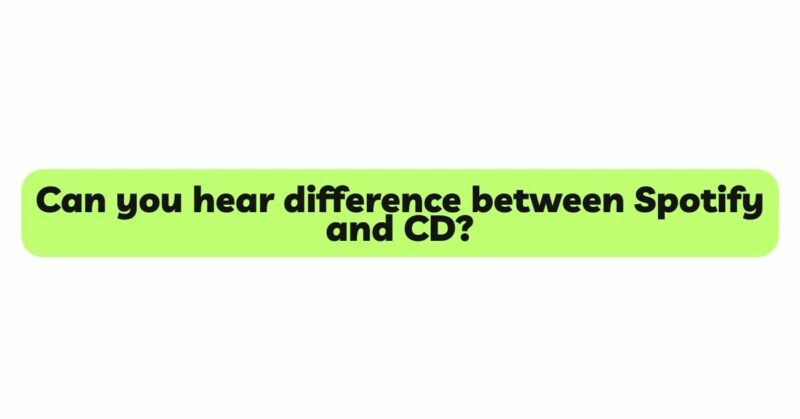As the digital age continues to redefine music consumption, streaming services like Spotify have revolutionized how we access and enjoy our favorite tunes. Concurrently, Compact Discs (CDs) have upheld their reputation for superior audio quality and pristine sound reproduction. The question that intrigues audiophiles and discerning listeners alike is whether there is a discernible difference in sound quality between Spotify and CDs. In this in-depth article, we will delve into the technical aspects of both mediums, explore the perceptual nuances in sound reproduction, analyze the impact of audio compression on streaming, and ultimately determine whether there is indeed a distinguishable sonic difference between Spotify and CDs.
- The Rise of Spotify: A Digital Melody in Motion
Spotify, the world’s leading music streaming platform, has transformed the way we experience music, offering vast music libraries and personalized playlists. We’ll explore the technical specifications of Spotify’s audio streaming, its compression methods, and the factors contributing to its widespread popularity.
- The Legacy of CDs: A Symphony of Precision
Introduced in the 1980s, Compact Discs raised the bar for audio quality, offering an uncompressed audio bitrate of 1,411 kbps. We’ll explore the technical specifications of CDs, their digital precision, and the reasons behind their reputation for superior audio fidelity.
- Understanding Audio Fidelity:
To assess whether there is a perceptible difference between Spotify and CDs, we must delve into the concept of audio fidelity and its essential components, including accuracy, dynamic range, frequency response, and signal-to-noise ratio.
- The Perception of Sound Quality:
Understanding how our auditory system perceives sound is pivotal in comparing Spotify and CDs. We’ll explore the science of psychoacoustics, which influences our perception of sound quality, and examine how this plays a role in distinguishing between both mediums.
- Subjective Listening Tests and Real-World Experiences:
Subjective listening tests offer valuable insights into the perceived differences in sound quality between Spotify and CDs. We’ll analyze the results of various listening tests and consider the experiences of audiophiles and music enthusiasts.
- Audiophiles’ Verdict:
Audiophiles, with their discerning ears and passion for high-fidelity sound, provide a unique perspective on the comparison between Spotify and CDs. We’ll explore their insights, preferences, and experiences with both mediums.
- The Impact of Audio Compression:
Audio compression is a vital component of music streaming, ensuring efficient data transfer and storage. We’ll delve into the intricacies of audio compression and analyze how this affects the sound quality of Spotify’s audio streaming.
- Comparing Spotify to CDs:
To determine whether there is a discernible difference in sound quality between Spotify and CDs, we’ll compare the technical aspects, perceptual differences, and subjective experiences of both mediums.
- The Role of Music Genres:
The choice of music genre can significantly influence the perceived sound quality on Spotify and CDs. We’ll discuss how different music genres, with their unique intricacies and nuances, may be affected by each medium.
- The Future of Sound Quality:
As technology continues to evolve, new audio formats and streaming advancements may emerge. We’ll explore the trends that may shape the future of sound quality on Spotify and CDs.
Conclusion:
The comparison between Spotify and CDs in terms of sound quality is a multifaceted exploration, encompassing technical specifications, perceptual nuances, and individual preferences. While Spotify offers unparalleled convenience and accessibility to a vast music library, CDs continue to be revered for their accurate sound reproduction. Whether there is a discernible difference in sound quality between Spotify and CDs depends on individual preferences, listening habits, and the value placed on audio fidelity. Regardless of the medium, the essence of music remains a universal language that connects us all, transcending the boundaries of audio formats, and enriching our lives with its timeless power and emotional resonance.


